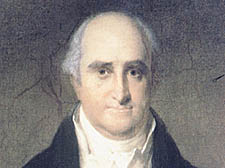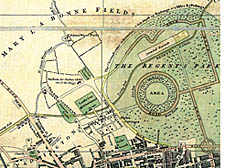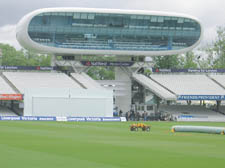
Thomas Lord, the founder of the famous cricket ground

A map of 18th-century London, showing how the capital ended at the other side of Regent's Park

The current Lord's cricket ground, showing the Nat West Media Centre |
Eleven Lords a-batting
Cricket was once an exclusive game and the great unwashed were unwelcome, so Lords was built to keep them out.
JUST over one hundred years ago there were plans to build a railway line which would carve its way through the middle of Lord’s Cricket Ground.
Such was the outcry that a deal was struck and the line neatly avoided the ground. It was the last of development plans that have struck Lord’s since the first ground was established in Dorset Square in the late 1780s.
A couple of weeks ago England opening batsman Andrew Strauss strolled down Park Road from Lord’s to unveil a plaque on a wall above the Regent’s Canal, marking the spot where Lord’s second ground had been situated for a few short years between 1809 and 1813.
Marking the spot of the ground had been the suggestion of Murad Qureshi, a London Assembly member, former Westminster councillor and cricket fanatic.
But such has been the development of the area that nothing of Lord’s second ground survives and the placement of the plaque prompted cricket historian David Rayvern Allen to ensure the history of Lord’s was not forgotten. He began trawling through archives in Westminster and Lord’s and he has just completed a pamphlet on the history of the ground.
“There really is nothing left to show the ground was there at all,” he says in the extensive library at the current Lords, the third incarnation of the ground. “It is easy to imagine cricket being played in Dorset Square, but here there are just buildings and, of course, the Regent’s Canal.”
Thomas Lord, a bowler and groundsman at the White Conduit club in Islington, first set up Lord’s, the spiritual home of cricket and the Marylebone Cricket Club (MCC) in 1788, a club established to offer the aristocracy and wealthy of London a more secluded spot to indulge in the game.
Previously, cricket was played on fields in Islington, as part of the White Conduit Club, but apparently the great unwashed of London would gather and watch the games.
Mr Rayvern Allen adds: “It became very popular and people, I suppose, enjoyed watching the aristocracy playing games, and there was a fair amount of ribaldry.”
Dorset Square was only a solution for a few years. As property in London spread inexorably outwards, rent was to increase substantially and Lord was forced to find a new piece of land in 1808.
He looked northwards and found a patch of land on the estate of the Eyre family who, in October of the same year, agreed to lease out two fields, for £54 per annum for 80 years.
Work to prepare the ground was carried out in the 1808/09 winter. By Spring it was ready.
Lord posted a notice in the Morning Post newspaper on April 27, 1809 announcing the opening the ground called Lord’s Saint John’s Wood Cricket Ground and he claimed that the “size and beauty of situation cannot be excelled”.
Mr Rayvern Allen says: “Lord was quite commercially minded and he had to be, each game would have cost about £70 to put on.”
Anyone coming to the ground would have to pass through Lord’s wine shop before entering.
But the pitch could not be described as a batting strip. There were no covers, of course, and the grass would be kept short by passing farmers, grazing sheep in the ground.
Mr Rayvern Allen has uncovered several score cards from the ground; half centuries were rare.
For the first two years the ground became the home of the St John’s Wood Cricket Club. The MCC only used the ground as its home between 1811 and 1813.
Regular players included many of Lord’s own friends, including Squire George Osbaldeston and Lord Frederick Beauclerk.
It was not to last long, however, as developers were eyeing up the land and the major threats were the plans to build the Regent’s Canal
Mr Rayvern Allen was born in 1938, has worked for the BBC, been a musician, and has been writing books on cricket for more than 30 years.
His publications include a biography of Aubrey Smith, the actor and captain of the Hollywood Cricket Club and recently A Breathless Hush, a collection of verse about cricket.
He continues: “Originally the Regent’s Canal was going to go just south of the ground but they altered the route so Lord realised that he had to move yet again.
“He did manage to get compensation, however, and the canal company paid him £4,700.”
So 1813 became the final year of cricket at the second ground, by 1814 Lords had established itself at its current site.
One hopes that developers would now be swiftly warded away from any plans that would threaten the ground. Mr Rayvern Allen chuckles: “There would be an outcry, but you never know what might happen.”
•
CLICK BELOW TO SEARCH FOR ACCOMODATION
|